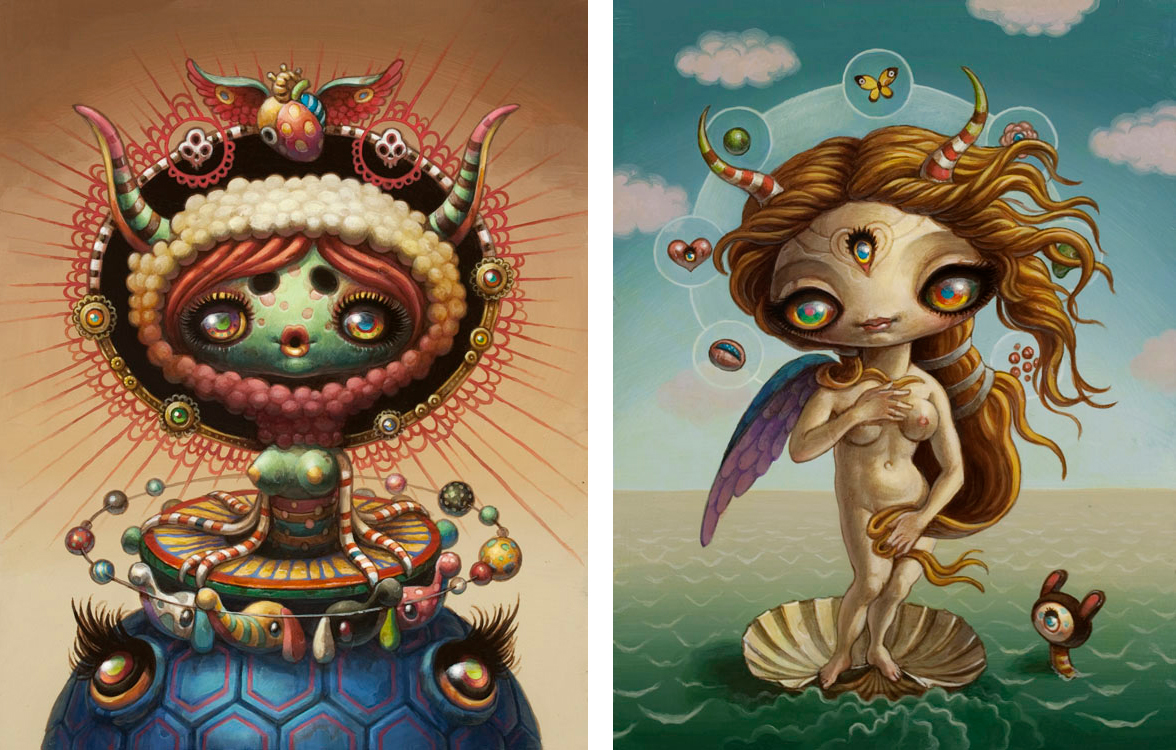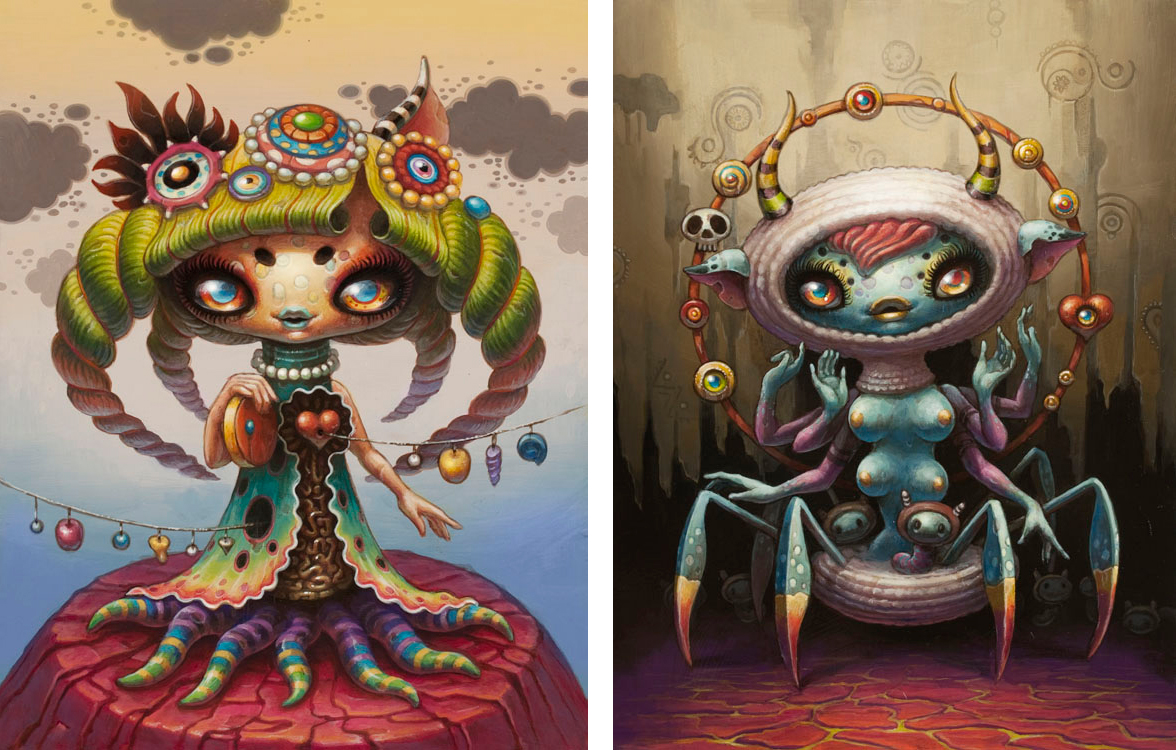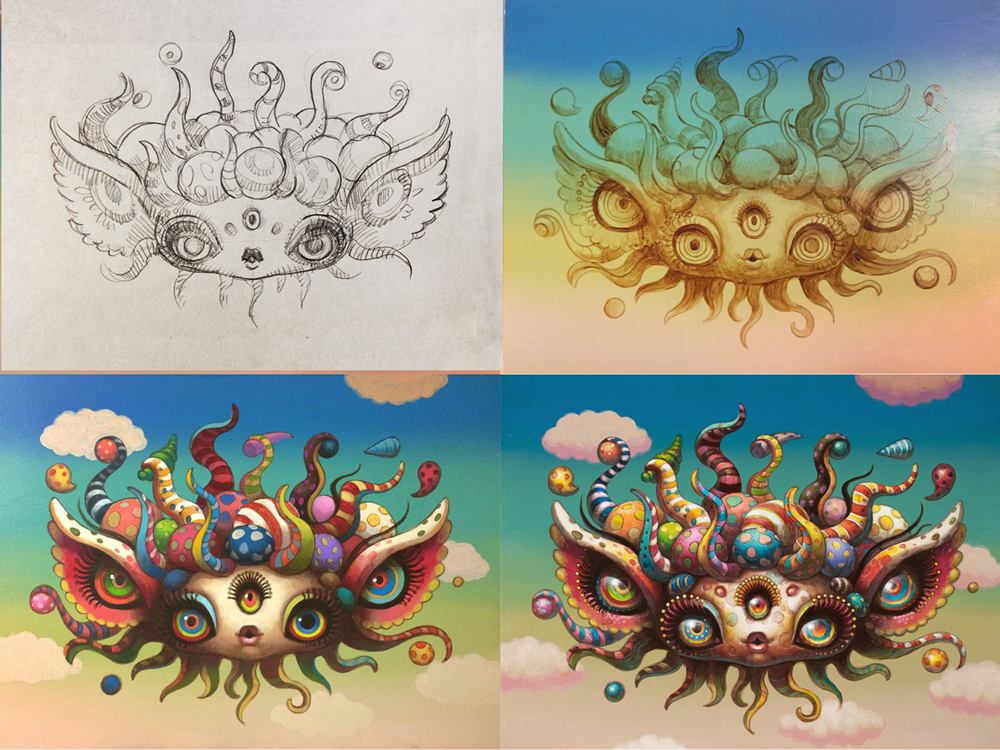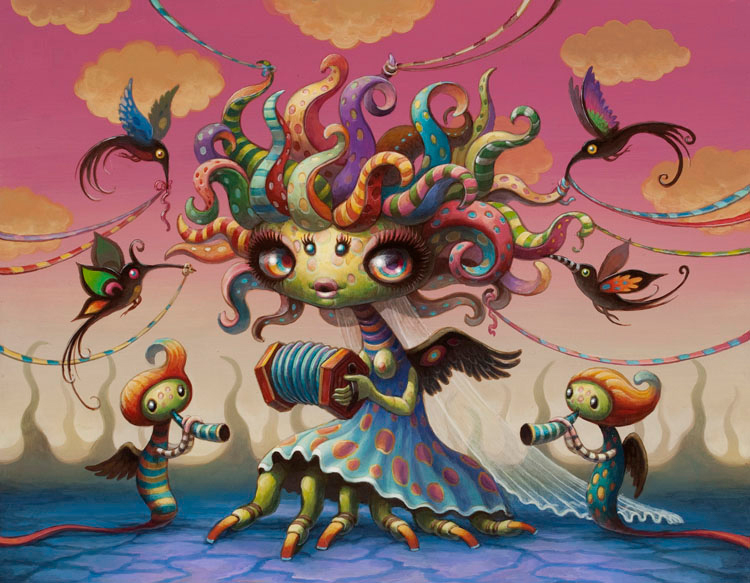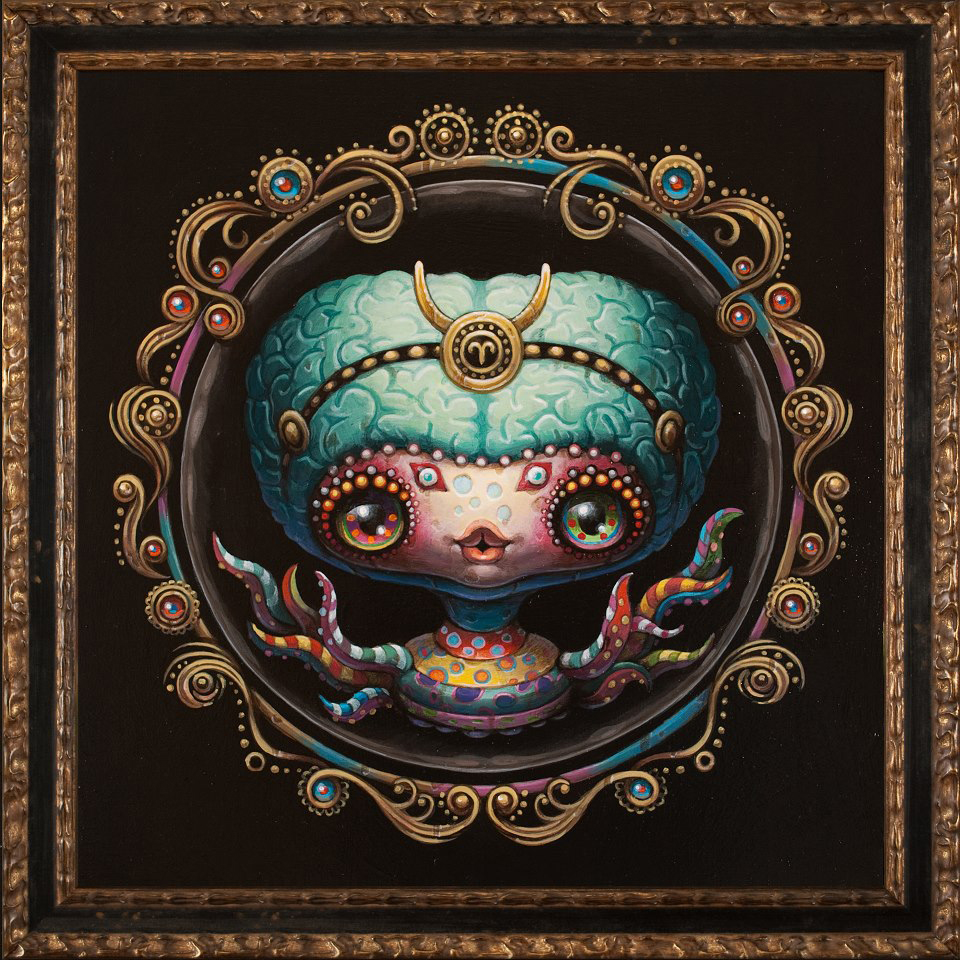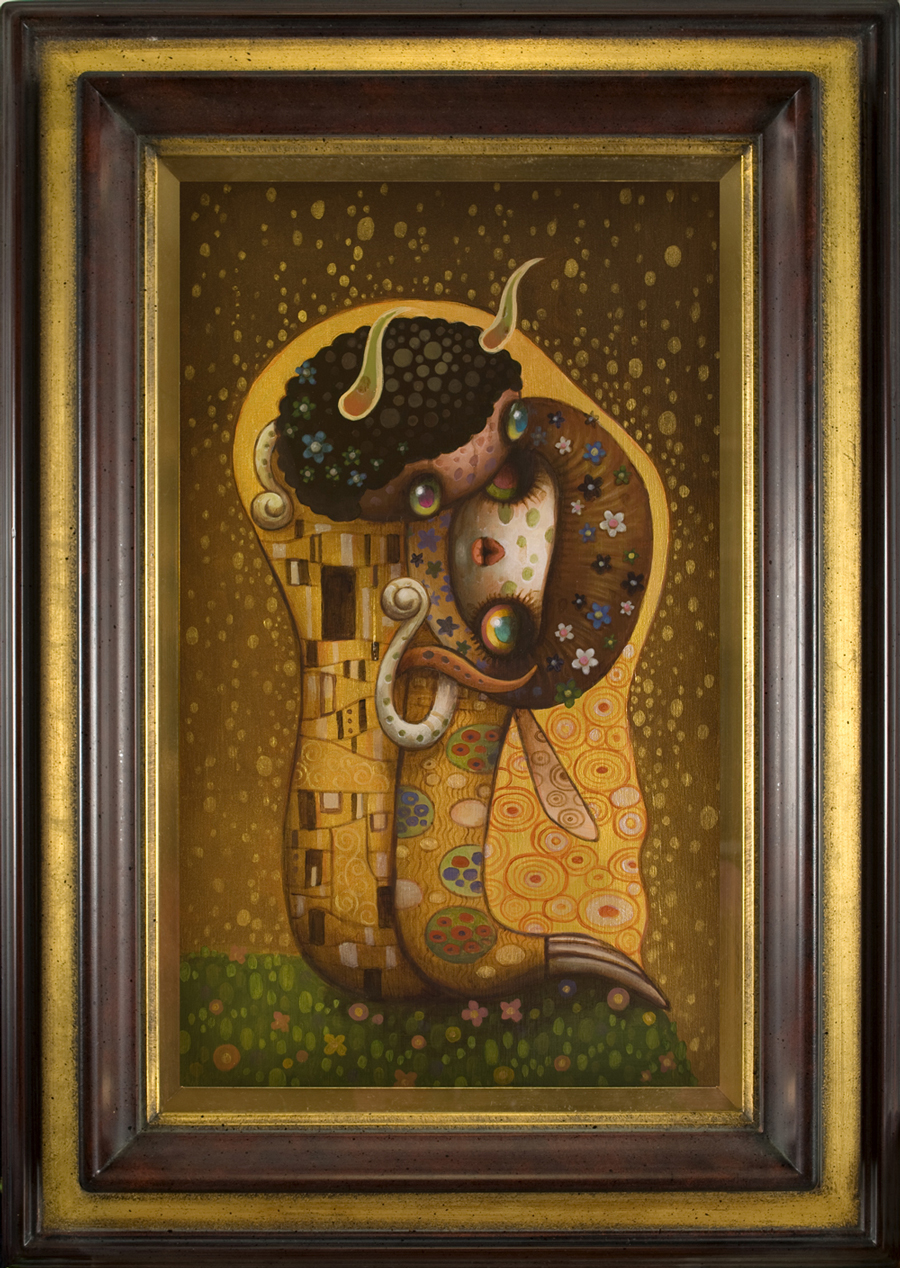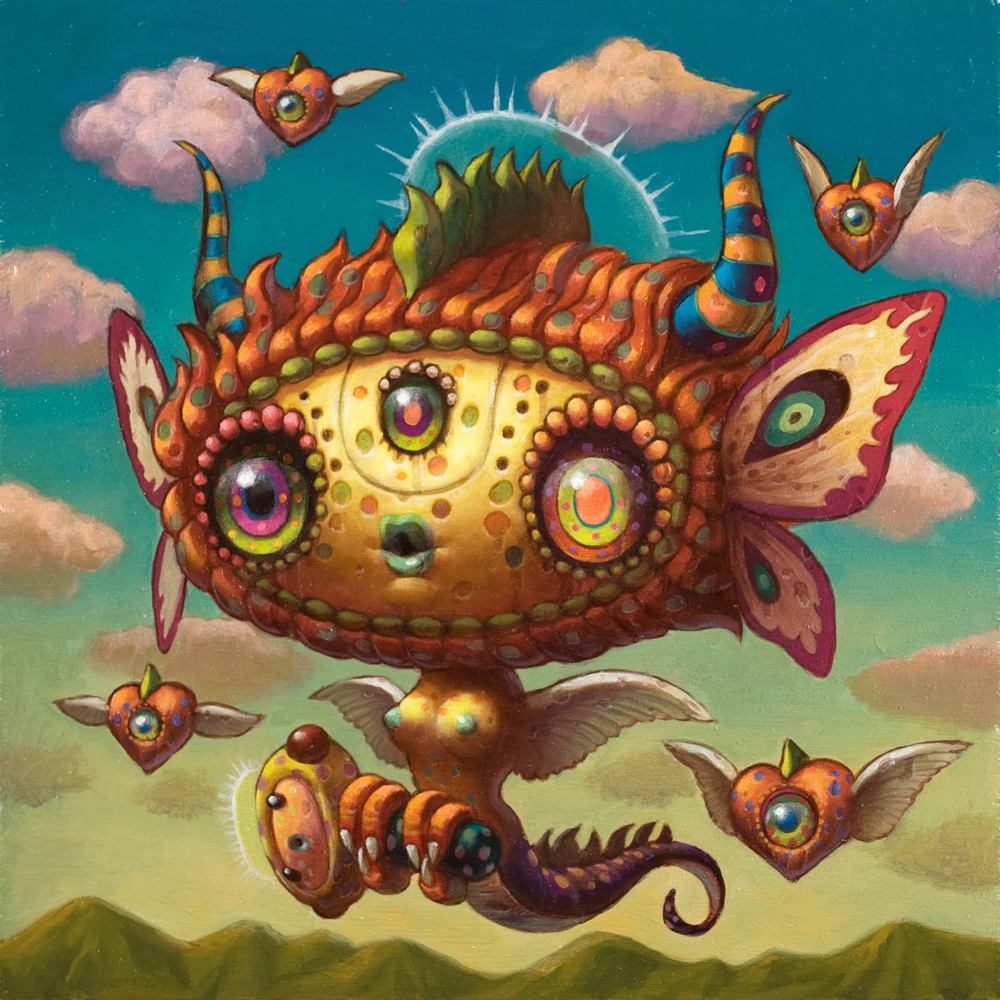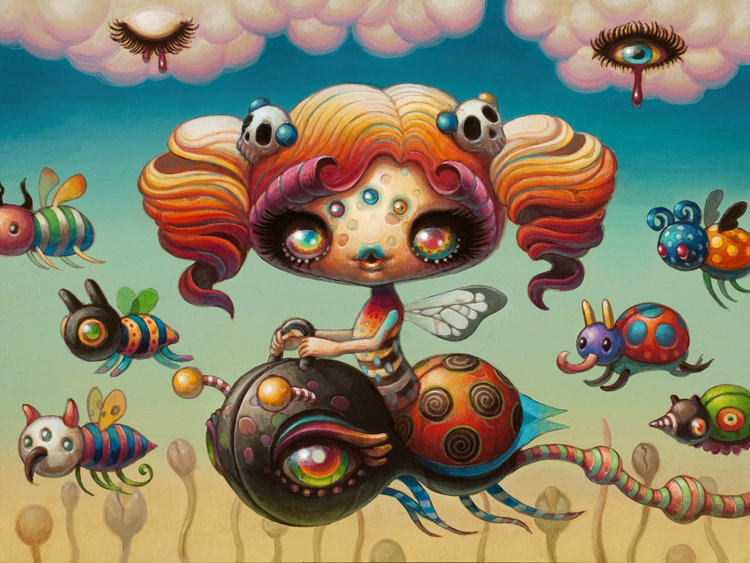Yoko d’Holbachie‘s is a Japanese painter who is best known for her psychedelic-colored surrealistic paintings of cute yet disconcerting creatures. Born in Yokohama (Japan) in 1971, she studied design and art at Tama Art University in Tokyo. Before she became a painter, she worked as a freelance designer for advertising agencies, publishers, video game companies, and the entertainment industry for almost 10 years. She began exhibiting her paintings in the U.S. in 2008 and has displayed her works at many different galleries around the world. From September 13 – October 4, 2014, her works are on display at Copro Gallery (in Santa Monica, Los Angeles, USA).
[Note: This interview is conducted in Japanese. Some things might be lost or added into the translation. So, if you are able to read Japanese, please read the Japanese version instead]
First of all, how do you pronounce d’Holbachie? Is that your real name? Do you pronounce it the way people pronounce the title of one of Kinniku Shoujo Tai‘s songs?
It can be pronounced Dolbacky [doll-bah-key], but I found the pronunciation and spelling in my dream. I know it’s difficult to spell and very difficult to pronounce. So, my friends in Japan call me Dol. The name has no direct relation to Dolbacky from Kinniku Shoujo Tai’s song, but I like Kinniku Shoujo Tai.
どのようにして、アティースとしてのキャリアを始めましたか?最初に開いた個展について覚えていることがあったら教えてください。また、なにがきっかけで個展を開けるようになったか教えてください。
私は自分の奇妙な友達を描く事を封印しながら、普通のデザイナーとしてマトモに仕事をしていましたが、それを廃業した直後に狂ったように大量の作品を描き上げ、それを渋谷の小さなギャラリーで展示しました。それを全部アメリカのとあるビジュアルアートのコンテストに出品して、入選したのがアーティストとして活動するきっかけです。
Your painting style is very unique. How did you come up with this style?
I’ve been imagining strange creatures ever since I was a child. Then, after I grew up and learned the basics of creating artworks, I started to use those imaginary creatures as the subjects of my paintings. I was a problematic child who kept on imagining and making up stories [about strange creatures]. Even I find it surprising and strange that I use those creatures as the main subjects of my art, and I’m very grateful that I have fans who appreciate my artworks.
YOKOさんの絵はとてもユニークだと思うのですが、どのようにして独自のスタイルを考え付いたんですか?
子供の頃から空想上の変な生き物と親しんでいたので、それを大人になって美術の基礎を学んだ後、絵として表現しているだけです。私は空想癖、虚言癖のある問題児だったのですが、その頃のイメージが今アートワークの作風となっているのはとても不思議で、さらにそれらを受け入れてくれるファンが存在するというのはとても幸運だと思います。
How did you start your career in art? Do you remember your very first exhibition? How did you make it happen?
Back then, when I worked as a designer, I stopped drawing/painting my strange imaginary friends. But, after I quit my job, I worked like mad creating whatever I want. I created so many paintings and exhibited them in small galleries in Shibuya (Japan). Then, I participated in a visual art contest in the U.S. I submitted all of those artworks I created (after I quit my job as a designer) and got an award. That was how I started to work as an artist.
どのようにして、アティースとしてのキャリアを始めましたか?最初に開いた個展について覚えていることがあったら教えてください。また、なにがきっかけで個展を開けるようになったか教えてください。
私は自分の奇妙な友達を描く事を封印しながら、普通のデザイナーとしてマトモに仕事をしていましたが、それを廃業した直後に狂ったように大量の作品を描き上げ、それを渋谷の小さなギャラリーで展示しました。それを全部アメリカのとあるビジュアルアートのコンテストに出品して、入選したのがアーティストとして活動するきっかけです。
What’s your typical process in creating a painting? How long does it take from start to finish?
It depends on the size of the painting, but it usually takes me around 2-3 weeks to finish a painting. I begin by creating sketches. I always sketch outdoors or in a cafe. I never sit and draw at my desk. Once I finish the sketch, I transfer the sketch onto a coated panel using carbon paper. I, then, use acrylic paint to complete the artwork.
創作の際、YOKOさんがよく行う描き方の過程はどのようなものですか? 創作始めだしてから、おおよそ完成するまでにどのくらいの時間を要しますか?
大きさにもよりますが、期間はだいたい1作品で2〜3週間くらいです。始めはアナログでラフを描きますが、必ず野外やカフェなどで、あまり机に向かってじっくり描く事はありません。ラフを元に下絵を完成させ、その後コーティングしたパネルにアクリルで背景の下地を塗ります。下絵はカーボン紙で転写して、着彩します。(行程画像添付しました。)
You mentioned that you teach art in Tokyo. How would you respond to your students if they asked you advice on how to create good surreal paintings?
I’ll tell the students that they need to be completely immersed in their dreamworlds. If their imaginations are too abstract; then, I will recommend them to – little by little – translate their imaginations into more concrete & easier-to-understand forms.
[That said, as it happens], most of my students do not want to create pop surrealism paintings.YOKOさんのウェブサイトに依りますと、東京でアートを教えていらっしゃるそうですが、もし、生徒さんが良いシューレアリズムを描くにはどうしたらいいですか?と聞かれたらどう答えますか?
自分の夢の世界に浸り切って描く事でしょうか。その結果できたものが抽象的すぎたら、それをすこしずつ分かり易いものに翻訳、変換していくように指導すると思います。
私の生徒にポップシュールを描きたい子は少ないですが。
Is there any detail or concept your fans might miss?
Though people who view my works are free to interpret my paintings any way they want, I often use butterflies and birds as symbols of reincarnation. I also use alchemical symbols as occult elements. I also like the story of how the world was born. Japanese legends and myths also really help me to create concrete subjects of my paintings.
外国人の方が見落としそうなコンセプト、細かい点(ディーティルなどがYOKOさんの絵の中にありますか?
見る人が好きなように見てくれればいいと思いますが、よく輪廻の象徴である蝶や鳥を入れたり、ちょっとオカルトな例えば錬金術の要素を入れたりしています。天地創造の話も好きで、日本の古い神話は私のイメージを具象化するのに良いモチーフになってくれます。
Among all of your works, do you have any favorites? Why do you love them more than the others?
One of my favorite paintings is called The Fate in the Tail. It’s one of my recent paintings and based on the story I heard when I was a child. The story is rather philosophical and scary. I was really happy (when I was painting the piece) and that feeling of happiness is reflected on the painting, by the vibrant colors I used to create the painting.
And, my other favorite is called Kiss. It’s an homage to Klimt’s famous painting,. Though my characters are not human, I was able to finish it without any hindrance.
数ある自分の作品の中で好きな絵はありますか? また、他の絵と比べて好きな点がありましたら教えてください。
最近描いた「fate in the tail」がお気に入りです。これは子供の頃にきいたすこし哲学的な怖い話にインスピレーションを受けて描いたにもかかわらず、この頃とても幸せを感じていて、それが絵に反映されて軽やかな絵に仕上がりました。
それから有名画がテーマのソロショーで描いた「KISS」はクリムトのkissの模写なのですが、まったく人間離れしたキャラクターにもかかわらず、実に自然に仕上がったので、想い出の作品です。
I’m afraid I’ve never heard about that story. But it sounds fascinating. Will you tell me about it?
In that story, every living thing has a long tail, and on the tip of each tail, there is a pouch. Every living thing drags the pouch around. Inside of the pouch, there are fortunes and misfortunes. But even though someone steals a pouch from a (seemingly) happy person, as s/he rips it open and look inside, all s/he finds is junk.
実はfate in the tale のモチーフになった話とはどういう内容のお話なのか非常に興味を引きました。簡潔にで構いませんので、内容をお教えいただければ幸いです。
全ての生き物は目に見えない長い尻尾のような袋を引きずりながら生きている…という話です。その中には幸運や不運の運命が詰まっていて、恵まれた幸せそうな人から袋を奪っても、破って中をて見るとそれはただのガラクタかもしれない…という内容です。
Please tell me a little bit about your show in Copro Gallery (Santa Monica, Los Angeles). How many paintings of yours are going to be on display? Is there any concept you want to convey through these works?
Copro Gallery is going to display 9 of my new paintings. The concept of the collection is Genesis, and the paintings are based on various countries’ myths and legends.
次展覧会のCoproギャラリーにYOKOさんの作品が展示されるそうですが、その事についてお聞きしたいことがあります。何作品のYOKOさんの作品が展示される予定ですか? 次に、今回のコンセプトはどのようなものですか?
コプロネイソンでは新作9作品が展示される予定です。コンセプトは天地創造で、色んな国の神話や伝承を元に、神様達が世界を創造する物語を紡いでいます。
And lastly, is there any message you’d like to say to Beautiful Bizarre readers?
I hope you will enjoy my world/point of view through my paintings.
After my exhibition at Copro Gallery, I will be having a solo exhibition at Akiza/La Galerie in Paris in October 25th. I will share previews of my new paintings for that show as well as my working process on my Facebook Page.
最後に、Beautiful Bizarreマガジンの読者に何かメッセージが御座いましたら何か一言お願いします。
どうぞ私の作品の世界観を楽しんでください!
コプロネイソンの後は、10月25日からパリの「Akiza / La Galerie」でソロショーがあります。ショーの作品や制作行程などはフェイスブックページで随時更新しています。
More information about the exhibition is available in Copro Gallery’s website.


